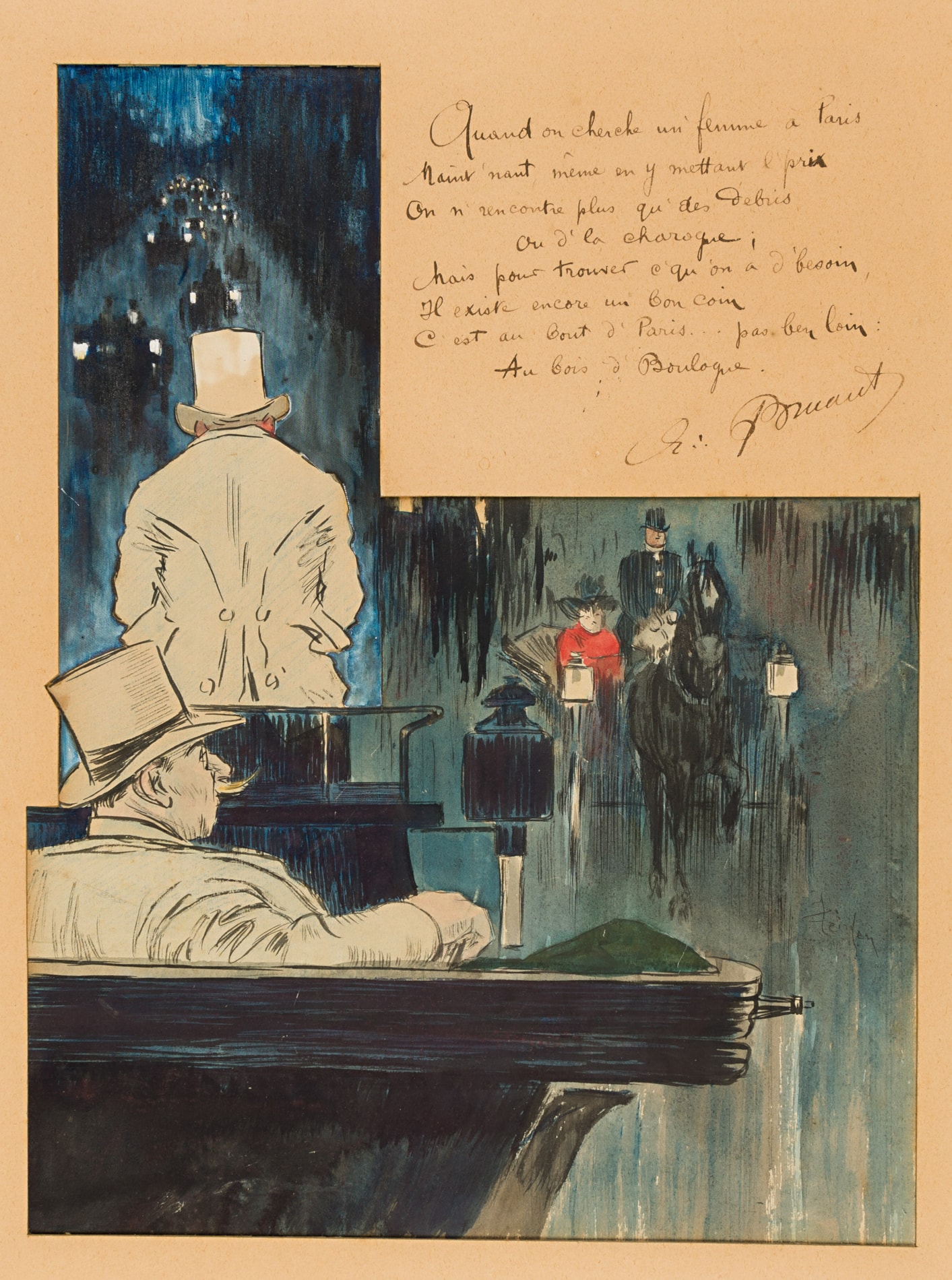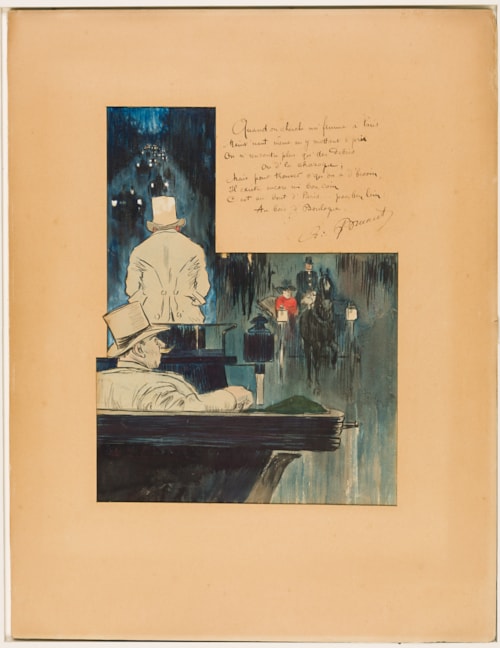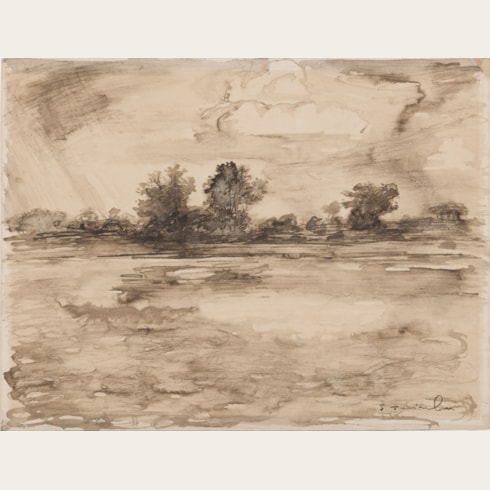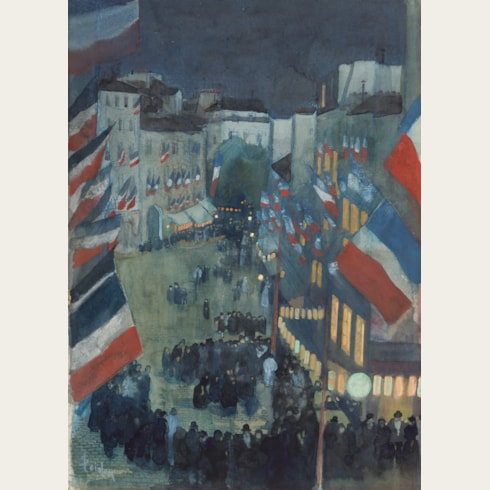Théophile-Alexandre STEINLEN
(Lausanne 1859 - Paris 1923)
Au Bois de Boulogne
Sold
Pen and black ink and watercolour, within an irregularly shaped overmount.
Signed Steinlen at the right centre.
Inscribed and signed (by Aristide Bruant) 'Quand on cherche un femme à Paris / Maint’nant même en y mettant l’prix / On n’rencontre plus qu’ des debris / ou d’la charogne; / Mais pour trouver c’qu’on a d’besoin / Il existe encore un bon coin / C’est au bout d’Paris…pas ben loin: / Au bois d’ Boulogne. A Bruant' on the mount.
289 x 219 mm. [sheet, at greatest dimensions]
Signed Steinlen at the right centre.
Inscribed and signed (by Aristide Bruant) 'Quand on cherche un femme à Paris / Maint’nant même en y mettant l’prix / On n’rencontre plus qu’ des debris / ou d’la charogne; / Mais pour trouver c’qu’on a d’besoin / Il existe encore un bon coin / C’est au bout d’Paris…pas ben loin: / Au bois d’ Boulogne. A Bruant' on the mount.
289 x 219 mm. [sheet, at greatest dimensions]
This drawing by Steinlen illustrates the song ‘Au Bois de Boulogne’ by Aristide Bruant, and was used for the cover of the July 1891 issue of Le Mirliton, a Parisian journal founded by Bruant in 1885 and named after his café of the same name. The cover, as eventually printed, incorporated the score and the lyrics of the song, which alludes to the nocturnal activities known to take place in the Bois de Boulogne, the large park near the western edge of Paris. The lyrics to the song, written by Bruant on the mount of this drawing by Steinlen, may be approximately translated as ‘When looking for a woman in Paris / Nowadays, even if one pays good money / We only meet debris / or carrion; / But to find what you need / There is still a good spot / It’s at the end of Paris ... not far away: / At the Bois de Boulogne.’
As Phillip Dennis Cate has noted of Bruant, ‘His songs were of street people…sung in the argot of the street. They circulated rapidly among the bistros and the unsavory parts of the city, and he soon became their chansonnier populaire…For ten and a half years, [Le Mirliton] appeared monthly, sometimes biweekly. It existed primarily to publicize Bruant’s songs, although later, in 1892, it developed into an organ for all Parisian café-concerts.’ Over a period of eleven years, Steinlen produced around 150 cover illustrations for Le Mirliton, for which Toulouse-Lautrec also worked. Between 1885 and 1889 Steinlen’s drawings for Le Mirliton were signed with the pseudonym ‘Jean Caillou’, while from 1890 onwards his illustrations were signed with his real name.
By 1896, however, Steinlen had stopped working with Bruant. As Cate has noted, ‘in spite of his numerous lighter-hearted images of bohemian life in Montmartre that are found especially in Aristide Bruant’s Le Mirliton and in Gil Blas illustré, Steinlen never strayed far from social commentary; he rarely abandoned his primary rôle of alerting his contemporaries to social evils…In 1896, after a more than ten-year association with Bruant as the principal designer of images to accompany the latter’s gutsy songs in Le Mirliton and the compilation of songs in the two volumes of Dans le rue (1888 and 1895), Steinlen declined to continue that work for the singer’s second volume of Sur la Route, because Bruant’s songs no longer shared the artist’s social realism.’
Several similar drawings by Steinlen illustrating songs by Bruant are in the collection of the Musée du Petit Palais in Geneva, while other comparable drawings for Le Mirliton include four sheets formerly in the collection of Boris Kochno and sold at auction in Monte Carlo in 1991.
The present sheet may perhaps be identified as one mentioned in passing in the English periodical The Athenaeum in April 1905: ‘Two interesting art sales were held at the Hôtel Drouot, Paris, at the end of last week. One of these consisted of pictures and drawings by Toulouse-Lautrec and Steinlen. Some, if not all of those by the latter were at one time in the collection of that notorious chansonnierAristide Bruant, and served to illustrate Bruant’s two collected editions of verses. The Steinlen drawings, for the most part, realized only small prices, 500 francs being paid for one called ‘Au Bois de Boulogne,’ and 300 fr. for ‘Aus Bois de Vincennes’.’
As one scholar has written, ‘Steinlen’s work for Le mirlitonreflects some of the social conditions of the last quarter of the 19th century…Steinlen vividly recreates a distinctive aspect of Paris in the 1890s – the bourgeoisie’s predilection for mingling with the lower classes. Steinlen’s greatest gift is his ability to capture essential aspects of contemporary life. In encouraging him in the depiction of such themes, Bruant and Le mirlitonhelped to shape Steinlen’s art.’
This same drawing by Steinlen was also used for the cover of the 1 November 1891 issue of the literary and artistic review La Plume; an issue devoted to the ‘chanson moderne’.
As Phillip Dennis Cate has noted of Bruant, ‘His songs were of street people…sung in the argot of the street. They circulated rapidly among the bistros and the unsavory parts of the city, and he soon became their chansonnier populaire…For ten and a half years, [Le Mirliton] appeared monthly, sometimes biweekly. It existed primarily to publicize Bruant’s songs, although later, in 1892, it developed into an organ for all Parisian café-concerts.’ Over a period of eleven years, Steinlen produced around 150 cover illustrations for Le Mirliton, for which Toulouse-Lautrec also worked. Between 1885 and 1889 Steinlen’s drawings for Le Mirliton were signed with the pseudonym ‘Jean Caillou’, while from 1890 onwards his illustrations were signed with his real name.
By 1896, however, Steinlen had stopped working with Bruant. As Cate has noted, ‘in spite of his numerous lighter-hearted images of bohemian life in Montmartre that are found especially in Aristide Bruant’s Le Mirliton and in Gil Blas illustré, Steinlen never strayed far from social commentary; he rarely abandoned his primary rôle of alerting his contemporaries to social evils…In 1896, after a more than ten-year association with Bruant as the principal designer of images to accompany the latter’s gutsy songs in Le Mirliton and the compilation of songs in the two volumes of Dans le rue (1888 and 1895), Steinlen declined to continue that work for the singer’s second volume of Sur la Route, because Bruant’s songs no longer shared the artist’s social realism.’
Several similar drawings by Steinlen illustrating songs by Bruant are in the collection of the Musée du Petit Palais in Geneva, while other comparable drawings for Le Mirliton include four sheets formerly in the collection of Boris Kochno and sold at auction in Monte Carlo in 1991.
The present sheet may perhaps be identified as one mentioned in passing in the English periodical The Athenaeum in April 1905: ‘Two interesting art sales were held at the Hôtel Drouot, Paris, at the end of last week. One of these consisted of pictures and drawings by Toulouse-Lautrec and Steinlen. Some, if not all of those by the latter were at one time in the collection of that notorious chansonnierAristide Bruant, and served to illustrate Bruant’s two collected editions of verses. The Steinlen drawings, for the most part, realized only small prices, 500 francs being paid for one called ‘Au Bois de Boulogne,’ and 300 fr. for ‘Aus Bois de Vincennes’.’
As one scholar has written, ‘Steinlen’s work for Le mirlitonreflects some of the social conditions of the last quarter of the 19th century…Steinlen vividly recreates a distinctive aspect of Paris in the 1890s – the bourgeoisie’s predilection for mingling with the lower classes. Steinlen’s greatest gift is his ability to capture essential aspects of contemporary life. In encouraging him in the depiction of such themes, Bruant and Le mirlitonhelped to shape Steinlen’s art.’
This same drawing by Steinlen was also used for the cover of the 1 November 1891 issue of the literary and artistic review La Plume; an issue devoted to the ‘chanson moderne’.
A native of Lausanne, Théophile-Alexandre Steinlen began his artistic career as a designer of printed fabrics. In 1881 he moved to Paris, settling in Montmartre, and there began to frequent the literary cabaret known as Le Chat Noir, founded by a fellow Swiss expatriate, Rodolphe Salis. It was at Le Chat Noir that Steinlen met and befriended writers such as Paul Verlaine and the artists Jean-Louis Forain, Henri de Toulouse-Lautrec, Louis Anquetin, Henry Somm, Adolphe Willette, Félix Valotton and Emmanuel Poiré, known as Caran d’Ache, among others. The artists of Le Chat Noir established something of a private club or society of aesthetes, and Steinlen was soon contributing illustrations to the associated journal Le Chat Noir. The success of these set him on the road to becoming one of the foremost illustrators in Paris at the turn of the century. At times using the pseudonym ‘Jean Caillou’, Steinlen submitted drawings to other satirical publications, including Le Mirliton and, from 1891 onwards, Gil Blas illustré, for whom he made over four hundred drawings. It was the success of his work for Gil Blas illustré that established Steinlen’s reputation outside France. Among the more than thirty magazines to which he also contributed were Le Croquis, Le Rire, Cocorico, La Revue Illustrée, L’Assiette au Beurre and Le Canard Sauvage. In 1901 he became a naturalized French citizen.
Steinlen depicted all manner of Parisian society in his drawings and illustrations, with a particular emphasis on the life of the working class. Like his contemporaries Toulouse-Lautrec and Alphonse Mucha, he was also active as a designer of theatrical and cabaret posters; an important means of disseminating his work and one that greatly added to his popularity. A close friend and collaborator of the singer and songwriter Aristide Bruant, Steinlen provided illustrations for sheet music covers, and also illustrated a number of books, including Guy de Maupassant’s La Vagabond and Anatole France’s L’Affaire Crainquebille. He enjoyed the first of many successful exhibitions of paintings and drawings in 1894, and in 1909 gained the distinction of a room devoted solely to his work at the Salon d’Automne.
As a draughtsman, Steinlen employed a wide variety of media, including black, blue and coloured chalks, ink, pencil, watercolour and charcoal. A large group of drawings by the artist, numbering nearly 2,800 sheets, is today in the collection of the Louvre.
Steinlen depicted all manner of Parisian society in his drawings and illustrations, with a particular emphasis on the life of the working class. Like his contemporaries Toulouse-Lautrec and Alphonse Mucha, he was also active as a designer of theatrical and cabaret posters; an important means of disseminating his work and one that greatly added to his popularity. A close friend and collaborator of the singer and songwriter Aristide Bruant, Steinlen provided illustrations for sheet music covers, and also illustrated a number of books, including Guy de Maupassant’s La Vagabond and Anatole France’s L’Affaire Crainquebille. He enjoyed the first of many successful exhibitions of paintings and drawings in 1894, and in 1909 gained the distinction of a room devoted solely to his work at the Salon d’Automne.
As a draughtsman, Steinlen employed a wide variety of media, including black, blue and coloured chalks, ink, pencil, watercolour and charcoal. A large group of drawings by the artist, numbering nearly 2,800 sheets, is today in the collection of the Louvre.
Provenance
Probably Aristide Bruant, Paris
Probably the anonymous sale (‘Tableaux et dessins, oeuvres importants de de [sic] Toulouse-Lautrec, dessins originaux de Steinlen pour l’illustration des oeuvres de Aristide Bruant, Dans la Rue- Le Mirliton’), Paris, Hôtel Drouot, 13 April 1905, lot 39 (‘Au Bois de Boulogne’)
Lucien Goldschmidt, New York, in c.1965
André Candillier, Paris
Private collection, Paris.
Probably the anonymous sale (‘Tableaux et dessins, oeuvres importants de de [sic] Toulouse-Lautrec, dessins originaux de Steinlen pour l’illustration des oeuvres de Aristide Bruant, Dans la Rue- Le Mirliton’), Paris, Hôtel Drouot, 13 April 1905, lot 39 (‘Au Bois de Boulogne’)
Lucien Goldschmidt, New York, in c.1965
André Candillier, Paris
Private collection, Paris.
Literature
Le Mirliton, No.73, July 1891, reproduced on the cover; La Plume, 1 November 1891, reproduced on the cover; Aristide Bruant, Dans la Rue - Chansons et monologues, 1892, Vol.II; Possibly ‘Fine Art Gossip’, The Athenaeum, 22 April 1905, p.509.









